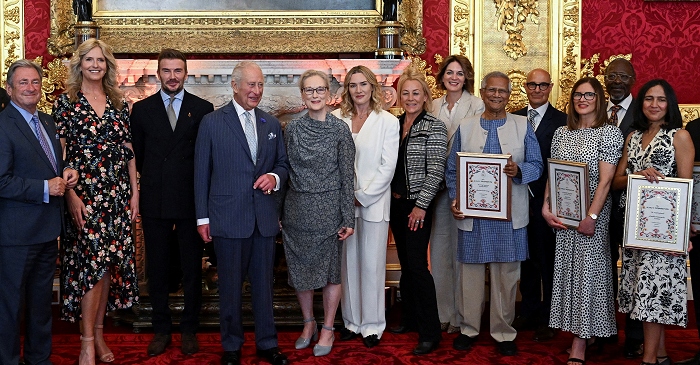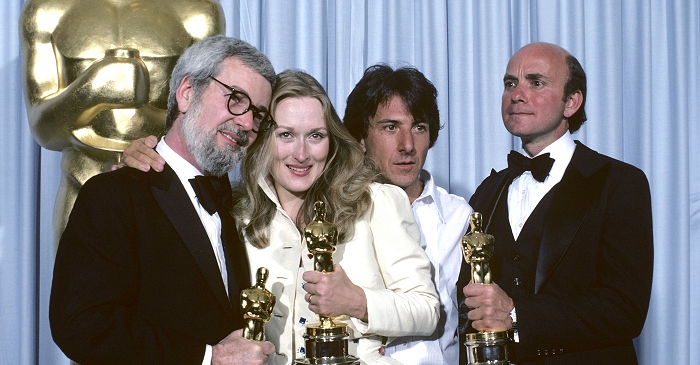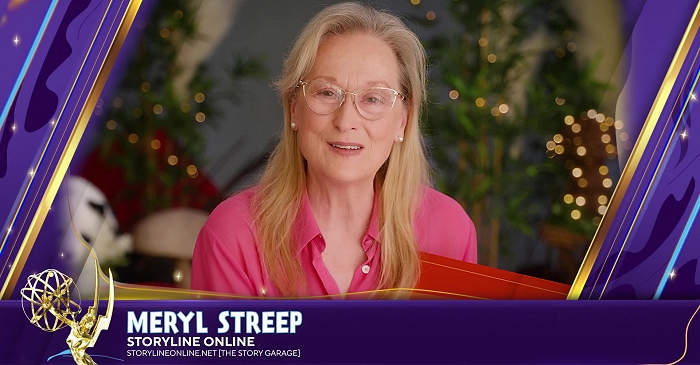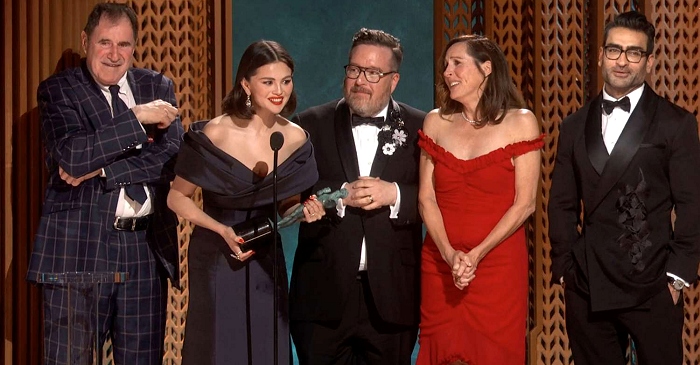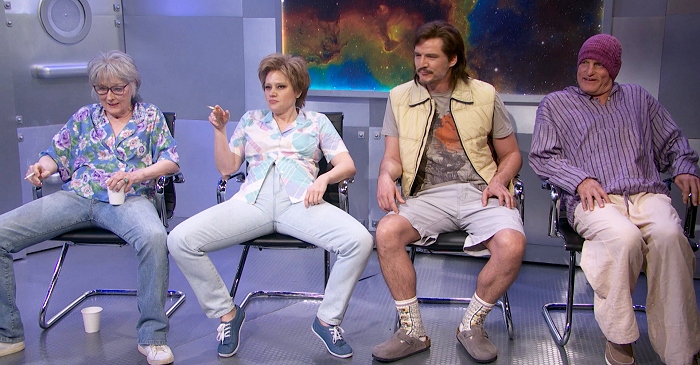|
Simply Streep is your premiere online resource on Meryl Streep's work on film, television and in the theatre - a career that has won her acclaim to be one of the world's greatest living actresses. Created in 1999, Simply Streep has built an extensive collection over the past 25 years to discover Miss Streep's body of work through thousands of photographs, articles and video clips. Enjoy your stay and check back soon.
|
|
Meryl Streep's Focus Is Work; Private Life Is Not For Sale
The Seattle Times ·
September 21, 1990
· Written by Glenn Plaskin
|
Dustin Hoffman once called her the “Eleanor Roosevelt of acting,” whatever that means. (“What’s he talking about,” she frowns, “an overbite?”) And Life magazine dismissed her physical allure. “Legs thick and short,” the magazine decided. “Hips pudgy, bust indistinct. . .” Meryl Streep has the last laugh. At 41, she’s riding a roaring wave that crested with her Oscar-winning performances in “Kramer vs. Kramer” (1979) and “Sophie’s Choice” (1982), then leveled in successes like “Silkwood” (1983) and “Out of Africa” (1985), followed in recent years by box-office low tides like “Plenty,” “Heartburn” and “Ironweed” – films she defends as “challenges” in a day of “male-oriented action” garbage.
Her current film, Mike Nichols’ “Postcards From the Edge,” is winning critical acclaim and early box-office success (it was No. 1 after it opened nationwide last weekend). Based on Carrie Fisher’s novel, “Postcards” is a melodramatic comedy revolving around a drug-addicted actress’s relationship with her domineering mother (Shirley MacLaine). “You know, your mother is always right,” Streep smiles. “You can fight it and fight it, but in the end, the mother in this film says I should sing rather than act – and I do.” Indeed, Streep the singer belts out a country-and-western finale, “I’m Checkin’ Out of This Heartbreak Hotel.” “I felt like I – me – had achieved something, because I’m intimidated to stand up in front of people. Terrible stage fright.” Stage fright? You’d never know it. She is self-effacing and immensely friendly, a bubbly woman who nonetheless instantly becomes all steel wariness at the first intrusion into personal matters. The focus is work, work, work. “My private life is not for sale.”
The record reflects a girl born Mary Louise Streep on June 22, 1949, in Summit, N.J., brainy but plain, all glasses and braces. She went to Vassar, then to Yale Drama School. After graduation, success assaulted her almost at once in “Julia.” “Dumb luck,” she explains, “and a willingness to try anything.” Tragedy struck when actor John Cazale, her only serious romantic involvement until then, died of bone cancer in 1978. Six months later, she met sculptor Donald Gummer, first becoming his roommate, then his wife. By all accounts, their marriage is a happy one. Low-key Gummer is a stay-at-home dad who relishes the little Gummers – Henry, 10, Mamie, 7, and Grace, 4. In a rare interview, Streep talks about film business sexism, blue moods, her lioness temper, the wretched state of films, and “feeling” her life.
You call “Postcards” one of the year’s first meaty movies with dialogue, minus race cars, gremlins, robocops and the Jetsons.
That’s true. Up where I live in Connecticut, there’s `Young Guns II,’ `Die Harder,’ `Total Recall,’ `Navy Seals.’ `Presumed Innocent’ would be esoteric.
Meryl Streep films wilt on the vine.
Yes. `A Cry in the Dark’ was a wonderful movie, but you can’t see a movie if it’s not anywhere. (Bitterly) I suppose distributors would rather have what they consider a blockbuster.
From a recent critic: “At a time in her career when she reportedly makes $4 million per film, her box-office appeal is waning. Despite seven Academy Award nominations, two Oscars, one Emmy, and a Tony nomination, audiences are staying at home.” Do you believe that and do you care?
No. I don’t believe it. The question about audiences turning away from me is . . . interesting. Audiences are shrinking. As the marketing strategy defines more and more narrowly who they want to reach – males from 16 to 25 – it’s become a chicken-and-egg syndrome. Which came first? First, they release all these summer movies, then do a demographic survey of who’s going to see them.
And in male-action films, actresses are second-class citizens. You’re paid $4 million. Bruce Willis, Harrison Ford, Schwarzenegger and Stallone make up to $10 million per film.
Men’s salaries are preposterous. If actresses had parity, you couldn’t make a movie. Men pay men more. Period.
So where does that leave an actress who isn’t a race-car driver or a sex symbol?
It makes my audience stay home. They watch me on videocassettes. You would be shocked to know there is a huge group that doesn’t go to the movies anymore – older people, smart people, poor people. I took six little children the other day and spent $38 on the concessions – not the tickets. This can’t last.
Any hope?
The pendulum is going to swing because self-styled blockbusters last summer didn’t do so well. `Days of Thunder’ cost $60 million and will probably make $40 million.
Your character in “Postcards,” Suzanne, is loaded down with humiliations: She’s tricked into sex just after she gets out of a drug clinic; she loses all her money; she’s badgered and bossed by her mother, and she sinks back into drugs.
She’s got problems. Yeah. But she also has a car, enough money to buy clothes, nice earrings, and parts in movies that people would kill to get into. So she’s the victim of her happiness as well as her misery.
At one point, she says: “I can’t feel my life.”
Exactly. That’s the one sentence that made me want to play this – the emotional hook for me. Suzanne is very insecure and doesn’t feel authentically herself. She’s more like the vernacular me than any character that I’ve played.
How are you and she alike?
That’s on parade in the movie. Her insecurities are mine, her willingness to go down the rosy path is my own.
With three kids, a nice husband, millions in the bank, and a world-class career, how can you compare Suzanne’s insecurity in the film to your own?
Look at everybody in Hollywood. Lots of them have those things, too, but they’re unable to feel those things, to fully register what it means to live where you are, and to be who you are. Suzanne’s feeling her life begins when she stops being a reaction to someone else – her mother – and starts living her own life and creating her own choices.
Most poignantly, she starts doing just that in the film’s penultimate scene, when a drunken Shirley MacLaine has driven herself into a tree and wound up in the hospital, minus her stage makeup.
Yes, that’s when mother and daughter come together, finally. There’s a great deal of love between them. The mother becomes the child, and the child becomes the mother. My mother in the picture, Doris, says she’s jealous of me, jealous that now it’s my turn. That’s the truth of when you finally pass the baton and you’re willing to let your child go.
Did you draw on anything in your relationship with your own mother?
Sure.
Back in July 1988, you attacked a photographer attempting to photograph your two older children, grabbing hold of the cameras around his neck and trying to rip them off, hitting him a couple of times.
I’m sorry I didn’t break his face. (Uproarious laughter) I get like a tigress when it’s about my kids. They get scared. It’s scary.
In your own life, what’s been the biggest problem?
I’ve had lots of scary personal things, lots of them.
Including John Cazale’s death.
Among them, yes, that. But I feel that’s my palette, that’s what I keep in my studio. You don’t get to see that. You get to see the painting.
Was John someone you would have married?
Ummm. (Pause) It’s really none of your damn business. I don’t parade those really meaningful things and I really distrust people who do. Then everything’s for sale. “I can say John’s death made the stakes all very high for me. It taught me about what’s meaningful, about what counts, that every second counts, that beyond anything you achieve, relationships between people count the most. My priorities were pretty drastically rearranged.
But when you have a really bad problem, what do you do?
I take my canoe out and float in the middle of the lake. Kurt Vonnegut says the wrinkles are smoothed out of the brain at the edge of a body of water. That’s true for me.
Water. Again, turning back to that most poignant scene of “Postcards From the Edge,” with Shirley MacLaine lying in a hospital bed without makeup, you tenderly apply her eyebrows and lipstick . . . and you both sing about water. . . .
(Softly) Yes, yes. Mama is at peace and if that scene without the makeup does anything, it allows you to see soul meeting soul without protection. That’s where they meet.
And the song…
The song is the demi-monde, one my own mother used to sing to me. A metaphor I didn’t even realize, until this moment, for life. One step at a time, one tiny thing at a time, makes a mountain. “(Singing softly) Little drops of water, little grains of sand… makes the ocean and the pleasant land…






